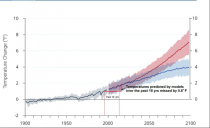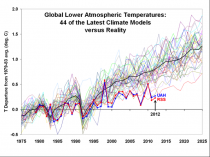By Dr Don Easterbrook, Dept. of Geology, Western Washington University, Bellingham, WA
Science is based on the ‘scientific method,’ which has been articulately described by Richard Feynman, a Cal Tech, nobel-prize-winning physicist.
1. Science is a method of finding things out by observation, experimentation, and testing, which is the ultimate judge of the truth of a concept.
2. If any exception to a concept can be proven by observation, the concept is wrong.
3. The number of scientists who believe something is irrelevant to the validity of a concept.
4. No government or other authority can decide the truth of a scientific concept.
5. All scientists are skeptics - bit is important to doubt in order to test concepts and look in new directions.
He outlines the necessary steps in using the scientific method as follows:
“In general, we look for a new law by the following process: First we guess it; then we compute the consequences of the guess to see what would be implied if this law that we guessed is right; then we compare the result of the computation to nature, with experiment or experience, compare it directly with observation, to see if it works. If it disagrees with the experiment, it is wrong. In that simple statement is the key to science. It does not make any difference how beautiful your guess is, it does not make any difference how smart you are, who made the guess, or what his name is- if it disagrees with experiment, it is wrong.” (Richard Feynman).
How well do claims and assertions in the just-released 890-page report by the NDC stack up against unequivocal, real-time data? Let’s apply the scientific method, as outlined by Feynman, to the NDC report. We’ll first state each assertion made in the NDC report, then test it against real-time observation and data. The report begins with dire predictions based on computer models, so let’s start with that. Here is their assertion, based on the graph below.
NDC assertion: “Temperatures are projected to rise another 2F to 4F in most areas of the United States over the next few decades.” “By the end of this century, a roughly 3F to 5F rise is projected under a lower emissions scenario, and a 5F to 10F rise for a higher emissions.”

Figure 1. NDC temperature predictions
Facts: How do we check the validity of this prediction? Well, we can look at comparisons of previous computer model results to recorded satellite temperatures. Figure 2 shows Roy Spencer’s plot of 44 of the latest climate models versus satellite measurements. As his graph shows, the models were not even close to the real measured temperatures. The obvious conclusion here is that the models failed miserably, a fact admitted to by the IPCC in their latest report.

Figure 2. Temperatures from 44 of the latest computer climate models plotted against UAH and RSS satellite temperature measurements. The models weren’t even close! (Spencer, 2014) Enlarged
Well, maybe the graph from the 16 climate models used in the NDC report weren’t included in the 44 models in the Spencer plot, so let’s check their particular model results by looking at the 18 year period of overlap of the NDC model results and satellite measurements in Figure 1. The graph shows that the computer model predicted an increase of 0.8 F during the past 18 years when satellite measurements record no warming at all! That’s a huge difference over such a time period, the modeled results are nowhere near reality. If the model can’t come any closer than 0.8 F in 18 years, why should we believe that it is any more accurate over the next 86 years to the end of the century? The modeled temperature predictions fail verification from measured temperatures and thus fail the Feynman test “If it disagrees with the experiment, it is wrong.” We can therefore confidently conclude that the NDC temperature predictions are not valid.
At this point, we might ask, since virtually everything else in the NDC report is based on these computer models, doesn’t that invalidate all that follows? It certainly invalidates their dire predictions, but the report also contains assertions that are based on claims other than from models. Don goes on one by one examining their validity here and finds them sorely lacking.
Pat Michaels on Obama climate report National Climate Assessment: ‘I was one of the reviewers on the report. I have read dozens of these compendia on climate change and this was the worst one I have ever read in my life. It’s one sided, it ignores tremendous amounts of the scientific literature. It is a document designed to tell a story and to give the President an excuse for a policy that no one wants..It is a boneheaded report for a President that has a tin ear on this issue. The drum beat goes on and on and on.’




